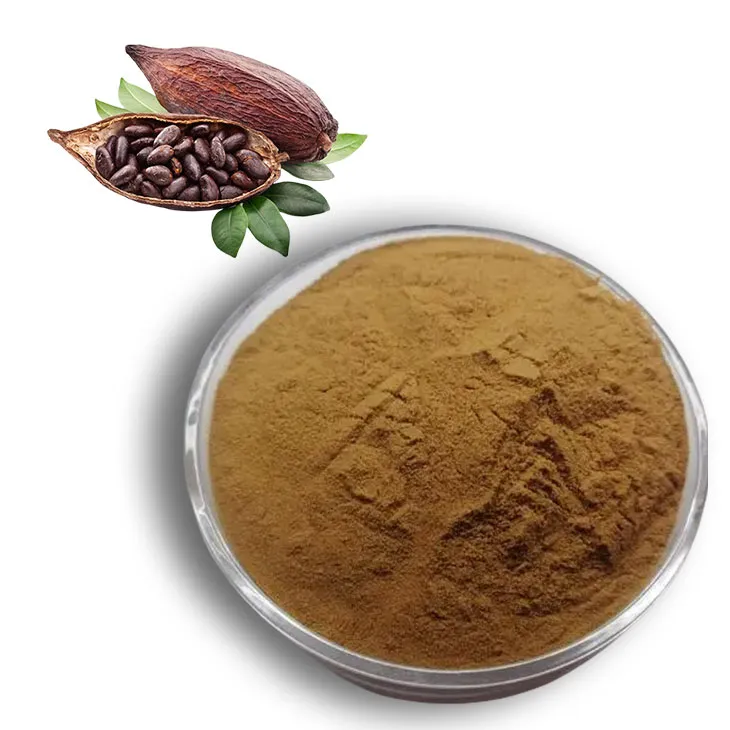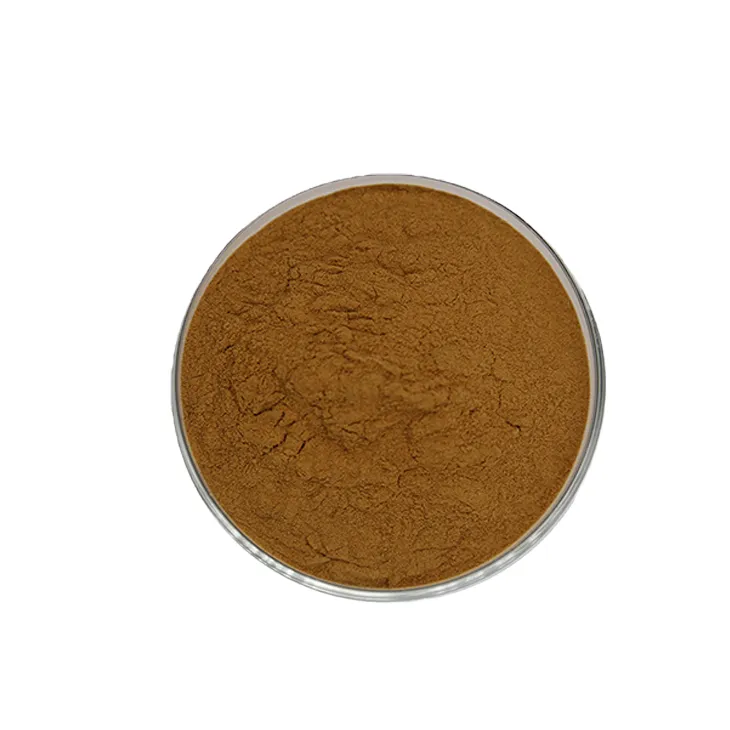- 0086-571-85302990
- sales@greenskybio.com
How to extract cocoa extract from plants?
2024-11-28

Introduction
Cocoa Extract is a highly valuable substance with a diverse range of applications. It is widely used in the food industry for its unique flavor and in the cosmetics industry for its antioxidant properties. The process of extracting Cocoa Extract from plants is a complex yet fascinating one, which this article will explore in detail.

Selection of Cocoa Plants
The starting point of Cocoa Extract production is the selection of suitable cocoa plants. The most common and important type of cocoa plant used is Theobroma cacao. This plant is native to the tropical regions of Central and South America and is known for its high - quality cocoa beans.
When selecting cocoa plants, several factors need to be considered:
- Genetic variety: Different genetic varieties of Theobroma cacao can produce beans with different flavors and chemical compositions.
- Soil quality: Cocoa plants thrive in well - drained, fertile soils rich in organic matter.
- Climate conditions: They require a warm, humid climate with an average temperature between 20 - 30°C and high rainfall.

Harvesting of Cocoa Pods
1. Determining the right time for harvesting
The ripe cocoa pods are the key source for obtaining high - quality cocoa beans. Determining the right time for harvesting is crucial. Ripe cocoa pods usually change in color, depending on the variety. For example, some varieties turn yellow or orange when ripe. Additionally, the pods should feel firm but not overly hard when gently squeezed.
2. Harvesting methods
Harvesting is typically done by hand. Workers use machetes or other sharp tools to carefully cut the pods from the trees. This method helps to avoid damaging the pods and the tree itself. It is important to note that the harvesting process should be carried out with care to ensure the integrity of the pods and the beans inside.

Removal of Beans from Pods
Once the cocoa pods are harvested, they need to be opened to remove the beans. This is usually done by making a clean cut along the length of the pod. Inside the pod, there are a number of beans surrounded by a white, mucilaginous pulp.
The beans are then separated from the pulp. This can be a somewhat labor - intensive process. In some traditional methods, the beans and pulp are left together for a short period to allow the pulp to start to break down, which can make the separation process a bit easier.

Fermentation of Cocoa Beans
1. Importance of fermentation
Fermentation is a crucial step in the process of obtaining cocoa extract. It is during fermentation that many of the flavor precursors are developed. Fermentation also helps to reduce the bitterness of the beans and enhance their overall flavor profile.
2. The fermentation process
The fermentation process typically lasts for several days. The beans are placed in large wooden boxes or baskets, often covered with banana leaves. During fermentation, microorganisms such as yeasts, bacteria, and fungi play a vital role. Yeasts are the first to start the fermentation process by converting the sugars in the pulp into alcohol. Bacteria then further convert the alcohol into acetic acid. The heat generated during fermentation can also reach up to 50°C in some cases.
3. Monitoring the fermentation
It is important to monitor the fermentation process carefully. Parameters such as temperature, pH, and the appearance of the beans need to be checked regularly. If the fermentation is too short, the beans may not develop the desired flavor. On the other hand, if it is too long, the beans can become over - fermented and develop off - flavors.
Drying of Fermented Beans
1. Reasons for drying
After fermentation, the cocoa beans need to be dried. Drying helps to reduce the moisture content of the beans, which is essential for their long - term storage and further processing. It also helps to stop the fermentation process and stabilize the flavor of the beans.
2. Drying methods
There are two main drying methods: sun drying and machine drying.
- Sun drying: This is a traditional method. The fermented beans are spread out on large trays or mats in the sun. Sun drying can take several days to a week, depending on the weather conditions. However, it is important to protect the beans from rain and excessive dust during this process.
- Machine drying: In modern cocoa processing, machine drying is often used. Drying machines can control the temperature, humidity, and air flow more precisely. This method is faster than sun drying and can produce more consistent results.
Roasting of Dried Beans
1. Purpose of roasting
Roasting is another important step in the production of cocoa extract. Roasting helps to further enhance the flavor of the cocoa beans. It also helps to develop the characteristic chocolatey aroma that we associate with cocoa products.
2. Roasting process
The roasting process is carried out at relatively high temperatures, usually between 120 - 150°C. The time of roasting can vary depending on the desired flavor profile. Shorter roasting times may result in a lighter, fruitier flavor, while longer roasting times can produce a darker, more intense, and roasted flavor.
During roasting, the beans undergo several chemical changes. The proteins and carbohydrates in the beans are caramelized, and the fats are melted, which contributes to the smooth texture of the final cocoa extract.
Grinding of Roasted Beans
After roasting, the cocoa beans are ground into a fine paste. This grinding process is important as it helps to break down the beans into a form that can be more easily processed further. Modern grinding machines can produce a very fine and homogeneous paste.
The ground paste contains all the components of the cocoa bean, including the cocoa solids, cocoa butter, and other compounds such as flavonoids, theobromine, etc.
Extraction of Cocoa Extract
1. Solvent extraction
One common method for extracting cocoa extract is solvent extraction. Ethanol is often used as a solvent. The ground cocoa paste is mixed with ethanol, and the mixture is stirred for a certain period. The ethanol then dissolves the flavonoids, theobromine, and other soluble compounds from the paste. After that, the mixture is filtered to separate the liquid (containing the cocoa extract) from the solid residue.
2. Supercritical CO₂ extraction
Supercritical CO₂ extraction is another advanced method. In this method, carbon dioxide is brought to its supercritical state (where it has properties of both a liquid and a gas). The supercritical CO₂ is passed through the ground cocoa paste. It can selectively extract the desired compounds, such as flavonoids, without leaving behind any solvent residues. This method is considered more environmentally friendly and can produce a high - quality cocoa extract.
Conclusion
The process of extracting cocoa extract from plants involves multiple steps, from the selection of cocoa plants to the final extraction method. Each step plays a crucial role in determining the quality and properties of the final cocoa extract. Whether it is for use in the food industry to create delicious chocolate products or in the cosmetics industry for its antioxidant benefits, understanding this extraction process is essential for those involved in the production and utilization of cocoa extract.
FAQ:
What is the first step in extracting cocoa extract from plants?
The first step in extracting cocoa extract from plants is harvesting the ripe cocoa pods from suitable cocoa plants, typically Theobroma cacao.
Why is fermentation important in the process of extracting cocoa extract?
Fermentation is important because it is crucial for developing the flavor precursors. During fermentation, which can last for several days, microorganisms play a vital role.
How are the fermented cocoa beans dried?
The fermented cocoa beans are dried either under the sun or in drying machines.
What happens after the cocoa beans are dried?
After the cocoa beans are dried, they are roasted to enhance the flavor further.
What methods can be used to obtain pure cocoa extract from the ground cocoa bean paste?
Solvents like ethanol or supercritical CO₂ extraction methods can be used to obtain the pure cocoa extract rich in flavonoids, theobromine, and other beneficial compounds from the ground cocoa bean paste.
Related literature
- Cocoa Extract: Production and Properties"
- "The Science of Extracting Cocoa Compounds from Theobroma cacao"
- "Advanced Techniques in Cocoa Extract Isolation"
- ▶ Hesperidin
- ▶ citrus bioflavonoids
- ▶ plant extract
- ▶ lycopene
- ▶ Diosmin
- ▶ Grape seed extract
- ▶ Sea buckthorn Juice Powder
- ▶ Beetroot powder
- ▶ Hops Extract
- ▶ Artichoke Extract
- ▶ Reishi mushroom extract
- ▶ Astaxanthin
- ▶ Green Tea Extract
- ▶ Curcumin Extract
- ▶ Horse Chestnut Extract
- ▶ Other Problems
- ▶ Boswellia Serrata Extract
- ▶ Resveratrol Extract
- ▶ Marigold Extract
- ▶ Grape Leaf Extract
- ▶ blog3
- ▶ blog4
-
High - quality kidney bean extract products.
2024-11-28
-
The best aged garlic extract on the market.
2024-11-28
-
How to make powder with L - arginine.
2024-11-28
-
Certified organic hawthorn extract.
2024-11-28
-
Bulk purchase of mulberry leaf extract.
2024-11-28
-
Wholesale Suppliers of Eyebright Extract.
2024-11-28
-
Horse Chestnut Extract
2024-11-28
-
Thunder God Vine Extract
2024-11-28
-
Gynostemma pentaphyllum extract
2024-11-28
-
Hawthorn powder
2024-11-28
-
Sugarcane Extract
2024-11-28
-
Coconut Water Powder
2024-11-28
-
Green Tea Extract
2024-11-28
-
Fenugreek Extract Powder
2024-11-28
-
Red Wine Extract
2024-11-28
-
Chasteberry Extract
2024-11-28





















